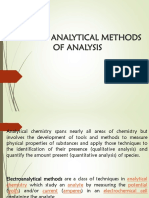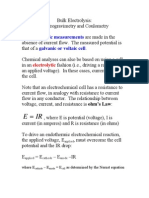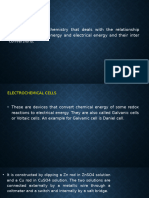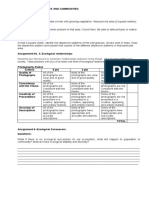Lecture 8 Electro-Kinetics
Lecture 8 Electro-Kinetics
Uploaded by
mainoCopyright:
Available Formats
Lecture 8 Electro-Kinetics
Lecture 8 Electro-Kinetics
Uploaded by
mainoCopyright
Available Formats
Share this document
Did you find this document useful?
Is this content inappropriate?
Copyright:
Available Formats
Lecture 8 Electro-Kinetics
Lecture 8 Electro-Kinetics
Uploaded by
mainoCopyright:
Available Formats
Electro-Kinetics
Description of Electrochemical
Techniques
The technique is named according to the
parameters measured
E.g.
Voltammetry measure current and voltage
Potentiometry measure voltage
Chrono-potentiometry measure voltage with
time (under an applied current)
Chrono-amperometry measure current with
time (under an applied voltage)
Electro-Kinetics
Movement of Ions
Butler Volmer Equation
Rotating Disc Electrode
Rotating Cylinder Electrode
Voltammetry
Cyclic Voltammetry
Chrono-potentiometry
Chrono-amperometry
Movement of Ions in Solution
Diffusion Movement under a concentration gradient. If
an electrochemical reaction occurs the current due to
this reaction is called, i
d
, the diffusion current.
Migration or Transport Movement of ions under an
electric field due to coulombic forces. If an
electrochemical reaction occurs the current due to this
reaction is called, i
m
, the migration current.
Convection Movement due to changes in density at the
electrode solution interface. This occurs due to depletion
or addition of a species due to the electrochemical
reaction.
The Capacitance Current
The charging or capacitance current, i
c
, is due to the
presence of the electrical double layer and it is always
present. This current, of course, is not related to any
movement of ions.
I
c
= C
dl
x V
Where:
C
dl
= the capacitance of the electrical double layer
V = voltage scan rate
The capacitance current makes its presence felt when
measuring charge transfer (Faradaic) processes at
concentrations of 10
-5
M.
Diffusion
Molecular diffusion,
often called simply
diffusion, is a net
transport of
molecules from a
region of higher
concentration to one
of lower
concentration by
random molecular
motion.
Migration or Transport
Is the fraction of current carried by the ions.
For example in a solution of copper sulphate the transport
number of Cu
2+
is 0.4 and that of SO
4
2-
= 0.6.
t
+
+ t
-
= 0.4 + 0.6 = 1
Since the migration current depends on the ionic strength of
the solution it is usually eliminated by addition of excess of an
inert supporting electrolyte (100 1000 fold excess in
concentration)
The current is carried by the inert supporting electrolyte (e.g.
NaCl , KNO
3
etc) because the ions produced do not undergo
any electrochemical reaction the transport current is
effectively removed.
In excess inert supporting electrolyte, the current measured
due to the electro-active species of interest is due only to
diffusion which can be related to mass transfer.
Voltammetry the following example shows how the migration
current is eliminated. Pb
2+
+ 2e Pb
0
The supporting electrolyte
Ensures diffusion control of limiting currents by eliminating
migration currents
Table: Limiting currents observed for 9.5 x 10
-4
M PbCl
2
as a
function of the concentration of KNO
3
supporting electrolyte
Molarity
of KNO
3
I
l
A
0 17.6
0.001 12.0
0.005 9.8
0.10 8.45
1.0 8.45
Voltammetry
The example shown is for the reduction of Pb
2+
at an
inert mercury electrode.
Pb
2+
+ 2e Pb(Hg)
At low inert electrolyte concentration a large fraction
of the total current is due to the migration current,
i.e. the currents due to the electrostatic attraction of
ions to the electrode.
For solution 1:
i migration i
m
17.6 8.45 = 9.2 A
i diffusion i
d
= 8.45 A
Ficks First Law of Diffusion
Fick's first law relates the diffusive flux to the
concentration field, by postulating that the flux goes
from regions of high concentration to regions of low
concentration, with a magnitude that is proportional
to the concentration gradient (spatial derivative). In
one (spatial) dimension, this is
x
D J
c
c
=
|
Ficks First Law of Diffusion
where
J is the diffusion flux in dimensions of [(concentration of
substance) length
2
time
-1
], example mole (M) m
-2
s
-1
.
J measures the amount of substance that will flow
through a small area during a small time interval.
D is the diffusion coefficient or diffusivity in dimensions
of [length
2
time
1
], example m
2
s
-1
| (for ideal mixtures) is the concentration in dimensions
of [(concentration of substance) length
3
], example M m
-3
x is the position [length], example m
x
D J
c
c
=
|
Ficks First Law of Diffusion
D is proportional to the squared velocity of the
diffusing particles, which depends on the
temperature, viscosity of the fluid and the size of the
particles according to the Stokes-Einstein
relationship.
In dilute aqueous solutions the diffusion coefficients
of most ions are similar and have values that at room
temperature are in the range of 0.6x10
-9
to 2x10
-9
m
2
/s.
For biological molecules the diffusion coefficients
normally range from 10
-11
to 10
-10
m
2
/s.
Ficks First Law of Diffusion
In two or more dimensions we must use, V, the del or
gradient operator, which generalises the first derivative,
obtaining
J = -D V |
The driving force for the one-dimensional diffusion is the
quantity - c|/cx
which for ideal mixtures is the concentration gradient. In
chemical systems other than ideal solutions or mixtures,
the driving force for diffusion of each species is the
gradient of chemical potential of this species. Then Fick's
first law (one-dimensional case) can be written as:
x RT
Dc
J
i
i
c
c
=
1
Ficks First Law of Diffusion
where the index i denotes the ith species,
c is the concentration (mol/m
3
),
R is the universal gas constant (J/(K mol)),
T is the absolute temperature (K), and
is the chemical potential (J/mol).
x RT
Dc
J
i
i
c
c
=
1
Butler-Volmer Equation
The Butler-Volmer equation is one of the
most fundamental relationships in
electrochemistry. It describes how the
electrical current on an electrode depends on
the electrode potential, considering that both
a cathodic and an anodic reaction occur on
the same electrode:
Butler-Volmer Equation
where:
I = electrode current, Amps
I
o
= exchange current density, Amp/m
2
E = electrode potential, V
E
eq
= equilibrium potential, V
A = electrode active surface area, m
2
T = absolute temperature, K
n = number of electrons involved in the electrode reaction
F = Faraday constant
R = universal gas constant
= so-called symmetry factor or charge transfer coefficient
dimensionless
The equation is named after chemists John Alfred Valentine Butler and
Max Volmer
Butler-Volmer Equation
The equation describes two regions:
At high overpotential the Butler-Volmer equation
simplifies to the Tafel equation
E E
eq
= a blog(i
c
) for a cathodic reaction
E E
eq
= a + blog(i
a
) for an anodic reaction
Where:
a and b are constants (for a given reaction and
temperature) and are called the Tafel equation
constants
At low overpotential the Stern Geary equation
applies
Current Voltage Curves for Electrode Reactions
Without concentration
and therefore mass
transport effects to
complicate the
electrolysis it is possible
to establish the effects of
voltage on the current
flowing. In this situation
the quantity E - E
e
reflects
the activation energy
required to force current i
to flow. Plotted below are
three curves for differing
values of i
o
with = 0.5.
Voltammetry
Although the Butler Volmer Equation predicts, that
at high overpotential, the current will increase
exponentially with applied voltage, this is often not
the case as the current will be influenced by mass
transfer control of the reactive species.
Take the following example of the reduction of ferric
ions at a platinum rotating disc electrode (RDE).
Fe
3+
+ e = Fe
2+
The rotation of the electrode establishes a well
defined diffusion layer (Nernst diffusion layer)
The contribution of the capacitance current will also
be demonstrated in this example.
Effect of the Capacitance Current in Voltammetry. The reduction of Ferric Chloride
is carried out in the presence of 1 M NaCl to eliminate the migration current.
Slope due to i
c
Applied Potential -Ve
Current
10
-5
M Fe
3+
Fe
3+
+ e Fe
2+
Current
10
-3
M Fe
3+
Fe
3+
+ e Fe
2+
Applied Potential -Ve
(a)
(b)
Note that the iE curve in Fig. (a)
is recorded at a much higher
sensitivity than in Fig. (b).
i
ld
i
ld
Charging Current or Capacitance
Current
Note that due to the presence of the electrical
double layer a charging or capacitance current
is always present in voltammetric
measurements.
Butler-Volmer Equation
where:
I = electrode current, Amps
I
o
= exchange current density, Amp/m
2
E = electrode potential, V
E
eq
= equilibrium potential, V
A = electrode active surface area, m
2
T = absolute temperature, K
n = number of electrons involved in the electrode reaction
F = Faraday constant
R = universal gas constant
= so-called symmetry factor or charge transfer coefficient
dimensionless
The equation is named after chemists John Alfred Valentine Butler and
Max Volmer
Butler Volmer Equation
While the Butler-Volmer equation is valid over the full
potential range, simpler approximate solutions can be
obtained over more restricted ranges of potential. As
overpotentials, either positive or negative, become larger
than about 0.05 V, the second or the first term of equation
becomes negligible, respectively. Hence, simple exponential
relationships between current (i.e., rate) and overpotential
are obtained, or the overpotential can be considered as
logarithmically dependent on the current density. This
theoretical result is in agreement with the experimental
findings of the German physical chemist Julius Tafel (1905),
and the usual plots of overpotential versus log current density
are known as Tafel lines.
The slope of a Tafel plot reveals the value of the transfer
coefficient; for the given direction of the electrode reaction.
Butler-Volmer Equation
( )
ial overpotent cathodic high at
exp
ial overpotent anodic high at
1
exp
0 `
0 `
(
=
(
=
RT
nF
i i
RT
nF
i i
c
c
a
a
q o
q o
i
a
and i
c
are
the exhange
current
densities for
the anodic
and cathodic
reactions
These equations can be rearranged to give
the Tafel equation which was obtained
experimentally
Butler Volmer Equation - Tafel Equation
n
b
i
n
a
i b a
i
n
i
n
i
n
i
n
i
nF
RT
i
nF
RT
o
a
a a
a
c
c c
c
c
c c
c
o
o
q
o o
q
o o
q
o o
q
059 . 0
ln
059 . 0
and
log
equation Tafel known well the is equation The
process anodic for the C 25 at log
059 . 0
log
059 . 0
process cathodic for the C 25 at log
059 . 0
log
059 . 0
ln ln
0
0
0
0
0
=
=
+ =
=
=
=
Tafel Equation
The Tafel slope is an intensive parameter and does not
depend on the electrode surface area.
i
0
is and extensive parameter and is influenced by the
electrode surface area and the kinetics or speed of the
reaction.
Notice that the Tafel slope is restricted to the number of
electrons, n, involved in the charge transfer controlled
reaction and the so called symmetry factor, o.
n is often = 1 and although the symmetry factor can vary
between 0 and 1 it is normally close to 0.5.
This means that the Tafel slope should be close to 120
mV if n = 1 and 60 mV if n = 2.
Tafel Equation
We can write:
( ) ( )
i i
nF
RT
b
i i b i i
nF
RT
log 303 . 2 ln
slope Tafel the
303 . 2
where
ln or ln
0 0
=
= =
= =
o
q
o
q
Current Voltage Curves for Electrode Reactions
Without concentration
and therefore mass
transport effects to
complicate the
electrolysis it is possible
to establish the effects of
voltage on the current
flowing. In this situation
the quantity E - E
e
reflects
the activation energy
required to force current i
to flow. Plotted below are
three curves for differing
values of i
o
with = 0.5.
Tafel Equation
The Tafel equation can be also written as:
where
the plus sign under the exponent refers to an anodic
reaction, and a minus sign to a cathodic reaction, n is
the number of electrons involved in the electrode
reaction k is the rate constant for the electrode
reaction, R is the universal gas constant, F is the
Faraday constant. k is Boltzmann's constant, T is the
absolute temperature, e is the electron charge, and
is the so called "charge transfer coefficient", the
value of which must be between 0 and 1.
Tafel Equation
The following equation was obtained
experimentally
Where:
q = the over-potential
i = the current density
a and b = Tafel constants
i b a log + = q
Tafel Equation
Applicability
Where an electrochemical reaction occurs in two half reactions on
separate electrodes, the Tafel equation is applied to each electrode
separately.
The Tafel equation assumes that the reverse reaction rate is
negligible compared to the forward reaction rate.
The Tafel equation is applicable to the region where the values of
polarization are high. At low values of polarization, the dependence
of current on polarization is usually linear (not logarithmic):
This linear region is called "polarization resistance" due to its formal
similarity to Ohms law
Stern Geary Equation
Applicable in the linear region of the Butler Volmer
Equation at low over-potentials
( )
resistance on polarisati measured the
3 . 2
constant Tafel the
Where
a
a
i E
R
B
R
B
i
p
c
c
p
corr
A A =
=
+
=
=
=
| |
| |
Tafel Equation
Overview of the terms
The exchange current is the current at equilibrium,
i.e. the rate at which oxidized and reduced species
transfer electrons with the electrode. In other words,
the exchange current density is the rate of reaction
at the reversible potential (when the overpotential is
zero by definition). At the reversible potential, the
reaction is in equilibrium meaning that the forward
and reverse reactions progress at the same rates.
This rate is the exchange current density.
Tafel Equation
The Tafel slope is measured experimentally; however,
it can be shown theoretically when the dominant
reaction mechanism involves the transfer of a single
electron that
T is the absolute temperature,
R is the gas constant
is the so called "charge transfer coefficient", the
value of which must be between 0 and 1.
F
RT
b
o
303 . 2
=
Levich Equation
The Levich Equation models the diffusion and solution
flow conditions around a rotating disc electrode (RDE). It
is named after Veniamin Grigorievich Levich who first
developed an RDE as a tool for electrochemical research.
It can be used to predict the current observed at an RDE,
in particular, the Levich equation gives the height of the
sigmoidal wave observed in rotating disk voltammetry.
The sigmoidal wave height is often called the Levich
current.
In work at a RDE the electrode is usually rotated quite
fast (1000 rpm) in order to establish a well defined
diffusion layer.
The scan rate is relatively slow typically 2-5 mV s
-1
Current Voltage Curve at a RDE
It is important to remember that in order to determine the
diffusion current and the mass transfer coefficient using
volatmmetry, excess inert supporting electrolyte must be
present to eliminate the migration current
Levich Equation
The Levich Equation is written as:
where
i
L
is the Levich current
n is the number of electrons transferred in the half reaction
F is the Faraday constant
A is the electrode area
D is the diffusion coefficient (see Fick's law of diffusion)
w is the angular rotation rate of the electrode
v is the kinematic viscosity
C is the analyte concentration
While the Levich equation suffices for many purposes,
improved forms based on derivations utilising more terms in
the velocity expression are available.
[1][2]
Rotating Disc Electrode
Levich Equation
Levich Equation
Levich Equation
It is important to note that the layer of solution immediately
adjacent to the surface of the electrode behaves as if it were
stuck to the electrode. While the bulk of the solution is being
stirred vigorously by the rotating electrode, this thin layer of
solution manages to cling to the surface of the electrode and
appears (from the perspective of the rotating electrode) to be
motionless.
This layer is called the stagnant layer in order to distinguish it
from the remaining bulk of the solution. The act of rotation
drags material to the electrode surface where it can react.
Providing the rotation speed is kept within the limits that
laminar flow is maintained then the mass transport equation is
given by the Levich equation.
Levich Equation RDE
The Levich equation takes into account both the rate of
diffusion across the stagnant layer and the complex solution
flow pattern. In particular, the Levich equation gives the
height of the sigmoidal wave observed in rotated disk
voltammetry. The sigmoid wave height is often called the
Levich current, i
L
, and it is directly proportional to the analyte
concentration, C. The Levich equation is written as:
i
L
= (0.620) n F A D
2/3
w
1/2
v
1/6
C
where w is the angular rotation rate of the electrode
(radians/sec) and v is the kinematic viscosity of the solution
(cm
2
/sec). The kinematic viscosity is the ratio of the solution's
viscosity to its density.
Current Voltage Curve at a RDE
I
limiting
vs e
(electrode rotational velocity)
Levich Equation - RDE
The linear relationship between Levich current and the square
root of the rotation rate is obvious from the Levich plot. A
linear least squares fit of the data produces an equation for
the best straight line passing through the data. The specific
experiment shown, the electrode area, A, was 0.1963 cm
2
, the
analyte concentration, C, was 2.55x10
6
mol/cm
3
, and the
solution had a kinematic viscosity, v, equal to 0.00916
cm
2
/sec. After careful substitution and unit analysis, you can
solve for the diffusion coefficient, D, and obtain a value equal
to 4.75x10
6
cm
2
/s. This result is a little low, probably due to
the poor shape of the sigmoidal signal observed in this
particular experiment.
The kinematic viscosity is the ratio of the absolute viscosity of
a solution to its density. Absolute viscosity is measured in
poises (1 poise = gram cm
1
sec
1
). Kinematic viscosity is
measured in stokes (1 stoke = cm
2
sec
1
). Extensive tables of
solution viscosity and more information about viscosity units
can be found in the CRC Handbook of Chemistry and Physics.
Cyclic Voltammetry
Cyclic Voltammetry is carried out at a stationary
electrode.
This normally involves the use of an inert disc
electrode made from platinum, gold or glassy carbon.
Nickel has also been used.
The potential is continuously changed as a linear
function of time. The rate of change of potential with
time is referred to as the scan rate (v). Compared to a
RDE the scan rates in cyclic voltammetry are usually
much higher, typically 50 mV s
-1
Cyclic Voltammetry
Cyclic voltammetry, in which the direction of the
potential is reversed at the end of the first scan. Thus,
the waveform is usually of the form of an isosceles
triangle.
The advantage using a stationary electrode is that the
product of the electron transfer reaction that occurred in
the forward scan can be probed again in the reverse
scan.
CV is a powerful tool for the determination of formal
redox potentials, detection of chemical reactions that
precede or follow the electrochemical reaction and
evaluation of electron transfer kinetics.
Cyclic Voltammetry
Cyclic Voltammetry
For a reversible
process
E
pc
E
pa
= 0.059V/n
The Randles-Sevcik equation Reversible systems
The Randles-Sevcik equation Reversible systems
n = the number of electrons in the redox reaction
v = the scan rate in V s
-1
F = the Faradays constant 96,485 coulombs mole
-1
A = the electrode area cm
2
R = the gas constant 8.314 J mole
-1
K
-1
T = the temperature K
D = the analyte diffusion coefficient cm
2
s
-1
( )
2 1
4463 . 0 RT nFvD nFAC i
p
=
( ) AC D v n i
p
2 1 2 1 2 3 5
10 687 . 2 =
The Randles-Sevcik equation Reversible systems
As expected a plot of peak height vs the square root of the scan rate
produces a linear plot, in which the diffusion coefficient can be obtained
from the slope of the plot.
Cyclic Voltammetry
Cyclic Voltammetry
Cyclic Voltammetry
Cyclic Voltammetry Stationary Electrode
Peak positions are related to formal potential of redox
process
E
0
= (E
pa
+ E
pc
) /2
Separation of peaks for a reversible couple is 0.059/n volts
A one electron fast electron transfer reaction thus gives
59mV separation
Peak potentials are then independent of scan rate
Half-peak potential E
p/2
= E
1/2
0.028/n
Sign is + for a reduction
Cyclic Voltammetry Stationary Electrode
The shape of the voltammogram depends on the transfer
coefficient o
When o deviates from 0.5 the voltammograms become
asymmetric -cathodic peak sharper as expected from Butler
Volmer eqn.
Web Sites
http://calctool.org/CALC/chem/electrochem/l
evich
http://www.calctool.org/CALC/chem/electroc
hem/cv1
Tafel Equation
The Tafel slope is an intensive parameter and does not
depend on the electrode surface area.
i
0
is and extensive parameter and is influenced by the
electrode surface area and the kinetics or speed of the
reaction.
Notice that the Tafel slope is restricted to the number of
electrons, n, involved in the charge transfer controlled
reaction and the so called symmetry factor, o.
n is often = 1 and although the symmetry factor can vary
between 0 and 1 it is normally close to 0.5.
This means that the Tafel slope should be close to 120
mV if n = 1 and 60 mV if n = 2.
Tafel Equation
We can write:
( ) ( )
i i
nF
RT
b
i i b i i
nF
RT
log 303 . 2 ln
slope Tafel the
303 . 2
where
ln or ln
0 0
=
= =
= =
o
q
o
q
Evans Diagrams
Evans Diagrams
Evans Diagrams
You might also like
- Solubility FESO4Document9 pagesSolubility FESO4Jesse JohnsonNo ratings yet
- NABARD Layer Farming ProjectDocument11 pagesNABARD Layer Farming ProjectGrowel Agrovet Private Limited.90% (40)
- Impedance Spectroscopy: Theory, Experiment, and ApplicationsFrom EverandImpedance Spectroscopy: Theory, Experiment, and ApplicationsEvgenij BarsoukovNo ratings yet
- Organometallic Transition Metal Catalysis: A Holistic Approach to Understanding and Predicting their MechanismsFrom EverandOrganometallic Transition Metal Catalysis: A Holistic Approach to Understanding and Predicting their MechanismsNo ratings yet
- Lecture 8 Electro-KineticsDocument63 pagesLecture 8 Electro-KineticsKhaled AbeedNo ratings yet
- Electrochemistry Lecture 2 - NotesDocument17 pagesElectrochemistry Lecture 2 - NotesCraftychemistNo ratings yet
- Drift+of+Carriers+in+Electric+and+Magnetic+Fields IVDocument8 pagesDrift+of+Carriers+in+Electric+and+Magnetic+Fields IVMuhammad ObaidNo ratings yet
- ButlerDocument3 pagesButlerAravindan B BabuNo ratings yet
- ButlerDocument3 pagesButlerBramuda MaulanaNo ratings yet
- Electrochemistry IDocument50 pagesElectrochemistry ISanjot KaurNo ratings yet
- Unit 1 ElectrochemistryDocument73 pagesUnit 1 ElectrochemistrySwaasNo ratings yet
- Namma Kalvi 12th Chemistry Unit 9 PPT Material EM 219459Document100 pagesNamma Kalvi 12th Chemistry Unit 9 PPT Material EM 219459RAMESH GNo ratings yet
- Controlled Current Techniques 1 PartDocument27 pagesControlled Current Techniques 1 PartAnkit Vishnoi100% (1)
- Physics of SemiconductorsDocument62 pagesPhysics of SemiconductorsAlvin Soriano AdduculNo ratings yet
- ch02 PDFDocument87 pagesch02 PDFPriyanka KatariaNo ratings yet
- ConductometryDocument14 pagesConductometryAmber IqbalNo ratings yet
- Conductometry 17th WeekDocument42 pagesConductometry 17th WeekpeetersNo ratings yet
- Instrumental AnalysisDocument7 pagesInstrumental AnalysisGabriel EngongaNo ratings yet
- CHAPTER 5 SemiconductorsDocument42 pagesCHAPTER 5 Semiconductors1553No ratings yet
- 3 PHDocument9 pages3 PHsoonaNo ratings yet
- Electrometric MethodDocument5 pagesElectrometric MethodmaaamahhyakasaiNo ratings yet
- Discussion of Principle (1-4) (Part 2)Document7 pagesDiscussion of Principle (1-4) (Part 2)Florence FlorendoNo ratings yet
- Circuit Electronics: An IntroductionDocument38 pagesCircuit Electronics: An IntroductionLu MeiNo ratings yet
- ConductanceDocument17 pagesConductance1bugattibolieNo ratings yet
- Conductometry 2Document43 pagesConductometry 2shivanee vyasNo ratings yet
- Eam of Analysis EditedDocument140 pagesEam of Analysis EditedAvishek KumarNo ratings yet
- Electrolytic Conduction NotesDocument94 pagesElectrolytic Conduction NotesPaolo Peps50% (2)
- Voltammetry: Fick's LawDocument5 pagesVoltammetry: Fick's LawMuhammad ArsalanNo ratings yet
- Electrochemistry - CL7002Document23 pagesElectrochemistry - CL7002vsneha2514No ratings yet
- 4.07 Ions in Aqueous Solution: (5 Points)Document9 pages4.07 Ions in Aqueous Solution: (5 Points)NadunKodikaraNo ratings yet
- Semiconductor PhysicsDocument42 pagesSemiconductor PhysicsDebajyoti DattaNo ratings yet
- Week14 PDFDocument32 pagesWeek14 PDFTrâm Con NítNo ratings yet
- ChronoamperometryDocument7 pagesChronoamperometrybettypaz89100% (1)
- PP 1Document33 pagesPP 1Vishnu IngleNo ratings yet
- Lecture Week 2 Carrier TransportDocument35 pagesLecture Week 2 Carrier TransportKejeindrranNo ratings yet
- Potentiometric Measurements Galvanic or Voltaic Cell: ElectrolyticDocument21 pagesPotentiometric Measurements Galvanic or Voltaic Cell: ElectrolyticAmr GamalNo ratings yet
- Theory of ElectrodepositionDocument32 pagesTheory of ElectrodepositionrthrbyNo ratings yet
- CV 1Document11 pagesCV 1Misaki 1No ratings yet
- Chapter1 FundamentalDocument96 pagesChapter1 FundamentalfrankieyiiNo ratings yet
- Analog Circuits Autumn2013Document84 pagesAnalog Circuits Autumn2013Thrinath Reddy LingalaNo ratings yet
- Langmuir Probes: Experiment 12Document10 pagesLangmuir Probes: Experiment 12Ferhat BozdumanNo ratings yet
- Discussion of Principle (1-4) (Part 2)Document7 pagesDiscussion of Principle (1-4) (Part 2)Neill TeodoroNo ratings yet
- 3.2 Electric CurrentDocument36 pages3.2 Electric CurrenttaufiqstuneNo ratings yet
- ElectricityDocument44 pagesElectricityKirancivilNo ratings yet
- Physical Chemistry II - Class 17Document24 pagesPhysical Chemistry II - Class 17PARVATHY ANIL - IMS20211No ratings yet
- Chapter Nine - ConductometryDocument28 pagesChapter Nine - Conductometryangel.lopez6383No ratings yet
- VoltammetryDocument37 pagesVoltammetrypramod_arya_htd100% (1)
- Cyclic VoltammetryDocument32 pagesCyclic VoltammetryAneeqa YounasNo ratings yet
- ElectrochemistryDocument50 pagesElectrochemistry4064 Harshitha Rampelly100% (2)
- Lec21 2011Document25 pagesLec21 2011ireall3017No ratings yet
- Electrical Conductivity and Ohms LawDocument35 pagesElectrical Conductivity and Ohms Lawqilastudy4No ratings yet
- ThermoelectricDocument13 pagesThermoelectricRama Mahesa RajaNo ratings yet
- CHM 403 Electrochemistry NoteDocument21 pagesCHM 403 Electrochemistry Notepeterononuju49No ratings yet
- Breakdown in InsulatorsDocument34 pagesBreakdown in InsulatorsShahabWazirNo ratings yet
- Corrosion Lecture KineticsDocument43 pagesCorrosion Lecture KineticsBaso Rahmat TarmiziNo ratings yet
- ThermoelectricDocument12 pagesThermoelectricRama Mahesa RajaNo ratings yet
- Electrochemistry CL EEE23 Ch1103Document95 pagesElectrochemistry CL EEE23 Ch1103munemshahriaronimNo ratings yet
- electrochemistry1713890756 (1)Document65 pageselectrochemistry1713890756 (1)F ZNo ratings yet
- Reflex KlystronDocument101 pagesReflex KlystronSusanWiliamNo ratings yet
- Session 1 ElectrochemistryDocument12 pagesSession 1 ElectrochemistryNandhakumarNo ratings yet
- Chemistry Cbse Project Srikaran Class XiiDocument17 pagesChemistry Cbse Project Srikaran Class Xiisreesowmiya5No ratings yet
- Craters of Large-Scale Surface Explosions PDFDocument5 pagesCraters of Large-Scale Surface Explosions PDFSinisa Gale GacicNo ratings yet
- 58203-mt - Process Modelling and SimulationDocument2 pages58203-mt - Process Modelling and SimulationSRINIVASA RAO GANTANo ratings yet
- Seneca Park Zoo Master Plan Concept 5-19-15Document5 pagesSeneca Park Zoo Master Plan Concept 5-19-15jmouleatcityNo ratings yet
- What Do You Look LikeDocument31 pagesWhat Do You Look LikeNguyễn Gia PhátNo ratings yet
- Research of Monggo SeedsDocument4 pagesResearch of Monggo SeedsSamuel Napone100% (1)
- Conveyo (CVO) : LED Conveyor Belt LightDocument4 pagesConveyo (CVO) : LED Conveyor Belt LightGabriel AcuñaNo ratings yet
- Grundig Cuc 7350Document3 pagesGrundig Cuc 7350pepitito22100% (1)
- Unit 8.1 - Project Scheduling Gantt ChartDocument2 pagesUnit 8.1 - Project Scheduling Gantt ChartAlyana GeriNo ratings yet
- Amniotic Fluid FairDocument9 pagesAmniotic Fluid Fairkrupapallavi nadimikeriNo ratings yet
- JNotes11 Venus-Sat in SignsDocument4 pagesJNotes11 Venus-Sat in SignsSri Nivas ShastriNo ratings yet
- Cristal 121 - FinalDocument1 pageCristal 121 - FinalSajukurian7No ratings yet
- Voltage Power MOSFET PDFDocument75 pagesVoltage Power MOSFET PDFPablo JoseNo ratings yet
- Cleft Lip & PalateDocument33 pagesCleft Lip & PalatedyahNo ratings yet
- Cladding To Timber FrameDocument34 pagesCladding To Timber Framecolinbooth91No ratings yet
- FT12 150 BatteryDocument2 pagesFT12 150 BatteryBarkah YanuarNo ratings yet
- Underground Obstacle RemovalDocument11 pagesUnderground Obstacle RemovalhutuguoNo ratings yet
- SAMSON Control Valves Type 3213 Type 3214 t5868Document12 pagesSAMSON Control Valves Type 3213 Type 3214 t5868Sai SarihadduNo ratings yet
- 5parameter ListDocument86 pages5parameter ListIsradani MjNo ratings yet
- Bab 2 Sel Sebagai Unit Asas HidupanDocument34 pagesBab 2 Sel Sebagai Unit Asas Hidupanadi8641No ratings yet
- Geostatistics For Environmental ScientistDocument15 pagesGeostatistics For Environmental ScientistFrancisco Javier Ceballos AravenaNo ratings yet
- Paper - Fatigue Lifetime of Welded Joints Under Random Loading - Colombini P., Dolinski K. - 2001Document11 pagesPaper - Fatigue Lifetime of Welded Joints Under Random Loading - Colombini P., Dolinski K. - 2001Claudio RodriguesNo ratings yet
- Im 4 Activities and AssignmentsDocument1 pageIm 4 Activities and AssignmentsAngel Mae Ob-aronNo ratings yet
- On BHEL and Its Organisation StructureDocument17 pagesOn BHEL and Its Organisation StructureAnkit Mehta0% (1)
- Rabbinical Council of America Edition of The Artscroll Siddur, P. 408Document4 pagesRabbinical Council of America Edition of The Artscroll Siddur, P. 408Yiṣḥâq Bên AvrôhômNo ratings yet
- SK106C14801 20210308 - SLEG - SF-G Simple Instruction V1.03-03Document4 pagesSK106C14801 20210308 - SLEG - SF-G Simple Instruction V1.03-03Amru Franky NawawiNo ratings yet
- Air India (Formerly Tata Airlines) : A Presentation by Jaideep BakreDocument10 pagesAir India (Formerly Tata Airlines) : A Presentation by Jaideep BakreArjun Jinumon PootharaNo ratings yet
- Map Guide KEDAH EnglishDocument2 pagesMap Guide KEDAH EnglishRAZIF CIVICZZNo ratings yet
- Lever Hoist ManualDocument40 pagesLever Hoist Manualbeshoy100% (1)

























































































